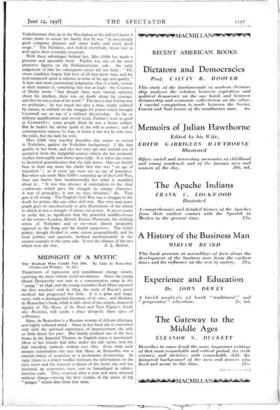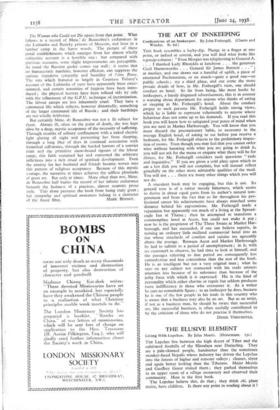MIDNIGHT OF A MYSTIC
The Woman Who Could Not Die. By Iulia de Beausobre. (Chatto and Windus. 8s. 6d.) The Woman Who Could Not Die. By Iulia de Beausobre. (Chatto and Windus. 8s. 6d.)
TRADITIONS of repression and punishment change slowly, outliving the most violent social revolutions. Since the young liberal Dostoevsky was sent to a concentration camp in the " purge " of 1848, and the young journalist Karl Marx reported the first wreckers' trial in 1854, the story of Russia's penal methods has progressed but little. It is a grim and tragic story, with a distinguished literature of its own ; and Madame de Beausobre's book, while it falls short of the simple, immortal dignity of The House of the Dead and Vera Figner's Nacht fiber Russland, will retain a place alongside these epics of st'fferance.
Mme. de Beausobre is a Russian woman of delicate physique and highly cultured mind. Since in her book she is concerned only with the spiritual experience of imprisonment she tells us little about her past. Her family retained one of the best boxes in the Imperial Theatre, an English nurse is mentioned. Most of her friends had titles under the old regime, and she had travelled, painted, written vers libre. Even with such meagre information one sees that Mme. de Beausobre was a natural object of suspicion to a proletarian dictatorship. In 1930 (there is a minor conflict between the information on the dust cover and the internal evidence of the book) she and her husband, an economist, were sent to Samarkand in admin- istrative exile. They returned after a year and were arrested without charge—among the first victims of the series of big " purges " which date from that time.
The Woman who Could not Die opens from that point. _ Whitt follows is a record of Mme' de Beausobre's endurances in the Lubianka and Butirky prisons of Moscow, and later in a lumber camp in the Sarov woods. The picture of these penal establishments which emerges from her almost wholly subjective account is a horrible one ; but compared with previous accounts, some slight improvements are perceptible. As usual the Russian gaoler comes out well ; it seems that no bureaucratic machine, however efficient, can suppress the curious impulsive sympathy and humility of l'dme Russe. The rats which featured so largely in Countess Tolstoy's account of the Lubianka of 192o have apparently been exter- minated, and certain amenities of hygiene have been intro-. duced ; the physical horrors have been refined side by side with the refinement of the G.P.U. technique of.incrimination. The labour camps are less inhumanly cruel. They have a communal life which reflects, however distortedly, something of the larger communal life of Russia ; and their hardships are not wholly deliberate.
But certainly Mme. de Beausobre was not a fit subject for them. Always ill, often on the point of death, she was kept alive by a deep, mystic acceptance of the necessity of suffering. Through months of solitary confinement with a naked electric light glaring all night and preventing her from sleeping, through a long blur of days in continual association with hysterical cell-mates, through the herded horrors of a convict train and the primitive snow-bound rigours of the labour camp, this faith sustained her and converted the arbitrary inflictions into a rich ritual of spiritual development. Even the anxiety for her husband and friends became woven into this pattern of religious acceptance. Because of this mystic courage, the narrative at times achieves' the selfless plenitude of great art. But only at times. More often than not, Mme. de Beausobre half buries the record of her infinite endurance beneath the lushness of a precious, almost neurotic prose style. This alone prevents the book from being truly great ; her sympathy and spiritual awareness belong to a character















































 Previous page
Previous page